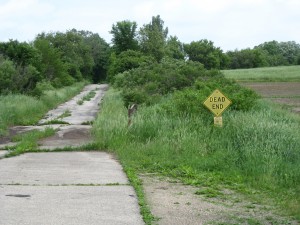
Dead End courtesy of monstersweare on Flickr
I’ve performed a bunch of free inbound marketing evaluations for businesses large and small. There are two mistakes I see companies making far more than any other. I covered the first mistake by describing why companies fail at social media. But there is another mistake that is even more common.
It seems that a majority of companies have conversion aversion.
This mistake is even more pervasive and costly. If you’re creating well-optimized, remarkable content and doing a bang-up job promoting that content via social media, what’s the point if you’re just sending them down a dead-end road? Converting those hard-earned visitors into leads is the final step in inbound marketing. And, frankly, it’s the only one that truly matters at the end of the day.
con-ver-sion a-ver-sion [kuhn-vur-zhuhn uh-vur-zhuhn]
noun
1. opposition to and/or apathy toward providing website visitors with strong calls to action
2. failure to describe the problem being solved or solution being offered
3. implementation of high-friction process for obtaining goods/content
Landing Pages to the Rescue
The first step in curing conversion aversion is the creation of landing pages. These pages are highly specialized and single-minded in their mission to achieve their goal. Each page’s goal must be clear and action-oriented (e.g. buy, download, join, etc…). What exactly is a landing page?

Ideally, a landing page contains a strong call to action, clear value proposition, and a low-friction conversion form. You’ll notice from the screen shot above that these are the only things on this page. The widgets have been removed in order to remove distractions. You don’t want to give visitors any extra shiny objects to take their attention away from the task at hand.
Crafting the Message
Create pages with compelling headlines.
It all starts with the headline. Along with the sub-heading, this is the main message that must communicate exactly what is being offered (Free Inbound Marketing Evaluation) and the problem that is solves (How well does your site compare? How can you improve it?). Focus on creating a vision for the audience that allows them to see how much better off they will be after taking the action you want them to take. Be sure to include one of the seven fascination triggers in your headline (lust, vice, alarm, power, prestige, mystique or trust).
Connect with the audience.
Build off of your headline by showing the audience that you can identify and empathize with their plight. People want to buy from people who are more like themselves.
Clearly define your offer.
Tell the customer exactly what they will get in exchange for their lead information (preferably no more than an email). Don’t get cute here – be extremely concise with your language and don’t hide anything.
Provide testimonials.
If people have made it this far, a powerful testimonial can seal the deal. Social proof is a vital aspect of the buying process.
Dispel their fears.
Try to anticipate the buyers’ reservations and address them head on. For example, tell them it won’t take as much time as they may think or won’t be as risky as they may fear. Making the offer completely risk-free (e.g. money back guarantee) is another way to accomplish this.
Low Friction
Every field of data the visitor must provide lessens the chances of conversion. Don’t ask for data just because you’d like to have it; only ask for the minimum amount of data required in order to fulfill the request. In many cases, the only field really and truly required is an email address. In the example shown above, some additional data is required because the offer is a free evaluation. As a general rule, the more valuable the offer is, the more friction users will tolerate.
Optimize
Which title should you use? What color is best for the submit button? Should you include a picture of the product or a human face?
Landing pages are incredibly fickle and tricky to optimize. Fortunately, there are some free tools available to help us to exactly that. Google Website Optimizer will allow you to create multiple versions of landing pages, then rotate them randomly and measure their respective conversion rates.
John,
Are there any statistics on how quickly a viewer of a website is turned into a calling prospect (telephone or e-mail) then converted to a purchasing customer?
Joe Kaulfersch
Joe – There’s no quick answer to that, unfortunately. It depends on whether or not you have an active lead-nurturing campaign that keeps leads warm and gives them reasons to convert. I haven’t seen any studies or published reports about conversion time frames. I suppose it also depends on the type of product and brand persistence.